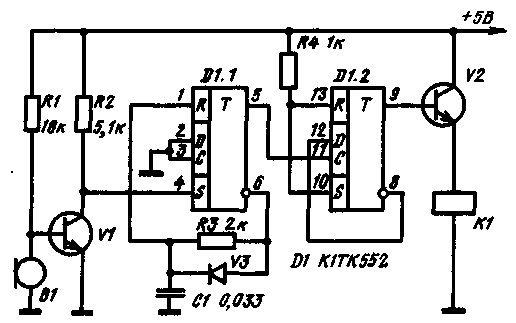The figure shows the scheme of an acoustic switch, which used an integrated chip. Thanks to her, the switch can be made very compact.
The device operates as follows. A microphone converts sound to an electric signal, and a cascade transistor V1 amplifies it to the required level. Next, the signal is supplied to a single-shot, collected on the element D1.1. In the initial state at the inverted output of single-shot D1.1 is a logical "1" and the true output of flip-flop D1.2 - 0. Therefore, the transistor V2 is closed and the actuator is disconnected by the relay contacts K1 (figure not shown). If the microphone clap your hands or say anything, a single-shot produces a short pulse which is fed to the input of the trigger D 1.2.

Last moves to another stable state: now at its output will be a logical "1". Transistor V2 opens and the relay K1 will work by connecting their contacts the actuator.
Inverted output of flip-flop D1.2 is connected to the input D, therefore, the logic level at this input will always be opposite to the direct output. Therefore, the next pulse generated by the single-shot D1.1, again will switch the trigger D1.2. the output now will be a logical "0" and the transistor V2 is closed.
Acoustic switch can be used in various systems of automation and electronic toys.
Note. Instead of transistors V1, V2 you can use any low power transistors corresponding structure, the diode V3 - any low-power rectifier. The microphone B1 must be coal.
Literature
Publication: N. Bolshakov, rf.atnn.ru






